
Razakars
Last updated: 5 October 2017 From the section 1971 Muktijuddho
At the beginning of the Swadhinata Juddho the Pakistani Army formed paramilitary groups within Bangladesh to aid them in fighting and controlling the Bengali nationalist.
The Shanti (Peace) Committee, Razakar (Volunteer), Al-Badr (The Sun) and Al-Shams (The Moon) were created and assigned a variety of combat and non-combat tasks. These included taking active part in the operations, spying against Mukti Bahini, interrogation, working as the guides of the Pakistani Army, killing and looting, forcing Hindus to convert to Islam, and providing manpower to the Pakistani Army.
Formation of the 'enemy from within'
The term Razakar (Persian for 'volunteer' or 'helper') was originally used in Hyderabad, India, in the 1940s to describe a private Islamic militia organised to support the oppressive rule of Osman Ali Khan and Asaf Jah VII.
In the context of the Bangladesh war of 1971 it came to mean 'collaborator' and refers to those local Bengalis and Biharis who collaborated with the West Pakistani army during the war. There were around 30,000 razakars who were raised after the 1965 Indo-Pak war in case of an Indian attack on East Pakistan and who remained loyal to the state and worked with the Pakistani regular troops
Among these razakars there were two kinds. One was the new militia formed by Pakistan Army who were visible to all, but the other kind – more wicked and treacherous, and often invisible - was the force that worked within the community and bled them internally. This kind, operated as informers, blackmailers, and as plunderers in the dark.
The Razakars, the main collaborators with the Pakistanis, were of two categories: the Mujahids, who were partly armed with obsolete rifles and guns; and the Ansaris, who were armed only with lathis and spears. The Mujahids were almost wholly composed of Bihari or other non-Bengali Muslims; the Ansaris were mainly Biharis but also contained some Bengalis - who of course defected to a man when the uprising started.
The Mujahids remained staunch henchmen of the Pakistanis throughout the genocide campaign and during the operations: they were responsible for innumerable acts of savagery and brutality under Pakistan Army's orders and were used on an organised scale to abduct young women for Pak officers and men. The Ansaris were not nearly as fanatical and, during the operations, large numbers gave themselves up to the Indian Army.
D. K. Palit, author of "The Lightning Campaign: The Indo-Pakistan War, 1971" (1972)
They were not driven by any ideology, but by money, opportunity to grab property and hobnob with the military authority to intimidate their neighbours. Unfortunately, the great majority of these mischief makers could not be brought to justice after liberation as they blended very quickly with the masses.
Ziauddin M. Choudhury, author of "Fight for Bangladesh" (2011)
Alleged 'fanatical' Islamic root of collaborators
Lacking manpower and local knowledge, the Pakistani authorities embraced emerging auxiliary units. After 25 March 1971, the Pakistani government dissolved some former Ansar Bahini who were voluntary forces formed by government of Pakistan on 12 February 1948 and used to help maintain safety and security in rural areas and remotest corners of the country. A large number of Ansars and officers joined the liberation war of Bangladesh during 1971 prompting the Pakistani military rulers to ban to the organisation and killing an estimated 9 officers and 635 Ansars during the Liberation War. The Ansar Bahini were gradually replaced by new, lightly armed razakars, consisting of the small mysterious Al-Badr and the larger Al-Shams. The razakars were formed in May 1971 by the Pakistan government in the model of the Razakar of Hydrabad.
It is widely believed that many of these militant groups were made up of dissident right-wing members from Jamaat-e-Islami (popularly known as just Jamaat), the largest Islamic group in Bangladesh - Nizam-e-Islami and Muslim League. They recruited members by inciting religious hatred as they portrayed the Bangladesh war as 'Mushrik' (Pagan) India and their Bengali agents trying to break up the largest Muslim state in the world (West-East Pakistan). As such many of their members came from college, university and madrasah background to 'protect' Islam from the 'Hindustan onslaught'. Matters were made worse by the close relationship which the Awami League - the East Pakistan's ruling party - had with their neighbour India. This bond exist even today as amongst the leading four parties in Bangladesh (Awami League, BNP, Jamaat-e-Islami and Jatiya Party), Awami League is seen as the most pro-India and secular (religiously neutral) party.
To Yahya Khan, the East Pakistani version of Islam was not good enough, the people of a mixed race from the Hinduinised population, not ‘pure’ Muslims. Not quite human. So easy to kill, subhumans.
Abu Zubair, author of "The Silent and the Lost" (2011)
East Pakistan Civil Armed Force (EPCAF) & 'Mujahids' created to aid Pakistanis
To relieve the regular army from border-holding duties, Tikka Khan raised a paramilitary force, known as the East Pakistan Civil Armed Force (EPCAF), to replace the old EPR by enlisting about 6,000 officers and men - but this time with a difference in that about 90% of the rank and file was from West Pakistan. A start was also made to raise Mujahids (literally meaning 'inner-struggler' but referring to one who engages in Jihad) from among the loyalists Biharis, as also Razakars (collaborators). This force (i.e. Mujahids) was to protect railway and road bridges, industrial and electrical installations and communication centres and other vulnerable targets from terrorist attack as well as create confidence amongst the local population. Major General Jamshed, a former director of EPR, was flown posthaste from West Pakistan to command this force. These measures were designed to strengthen Tikka Khan's grip on the administration of the province and win back the confidence of the Bengalis.
 Jamshed
Jamshed
Most Bengali troops remained initially quiet, and the lack of communication among scattered insurrectionists and between them and Bengali political leaders, do not support the thesis of a comprehensive plan for insurgency. Rather, mutual mistrust, fed by incoming news and rumours, created fluid situations that led troops, even within units, to watch each other suspiciously, a situation that could last for days or even a week locally.
Christian Gerlach, author of "Extremely Violent Societies: Mass Violence in the Twentieth-Century World" (2010)
Organisation
The Pakistani military assigned raids, intelligence, and commando objectives to Al-Badr, whilst Al-Shams were used mainly for securing objects like bridges. First the razakars operated under the Shanti Bahini (Peace Committees), established by older religious-conservative men in April and May 1971.
It was initially made up of 96 loyalist activists in the Ansar camp at Khan Jahan Ali Road in Khulna and expanded to other parts of Bangladesh.
The creation of the razakars was officially announced in late August 1971. In early September they were put under army command (in conjunction with the appointment of Dr. A. Malik as Governor and an amnesty). Their total number reached 35,000 - 55,000, below the Pakistani plans, and by late April there were just 5,000. Together with muhajirs and East Pakistan Civilian Armed Forces (EPCAF), their numbers reached 73,000.
At the initial stage, the razakars were subordinate to the local peace committees. By the promulgation of East Pakistan Razakar Ordinance on 1 June 1971, General Tikka Khan converted the Ansars into Razakars who were recognised as the members of the Pakistan army through an ordinance of the Ministry of Defence promulgated on 7 September.
The tenure of the primary training of the Razakars was 15 days. General Ameer Abdullah Khan niazi, chief of the eastern command of the Pakistan army, took salute at the closing parade at Savar on 27 November 1971 on completion of the training of the first batch of the company commanders of Razakar force. Subsequently, the Razakar force was elevated to the status of a separate directorate.
'Blurred boundaries between razakar and muktijuddha'
There are those that argue that some people became razakars for economic and political gain rather than their Islamic stance, and that the boundaries between razakars and muktijuddhas were blurred.
While villagers critique the alliances between elite liberation fighters and Razakars, the reasons for poor and illiterate people to be Razakars were often very nuanced [subtle differences in meaning]. Many became a Razakar in order to prevent torture, to relieve economic need, or to prevent reprisals against their family. When I visited the home of a man who was known to be a collaborator, I found that he and his wife readily acknowledged that he worked as a Razakar during the war. He added that there was no work and that they had to eat, so he hung around with the military and guarded bridges. Similarly, a Hindu fisherman told me that Muslim families had to be on both sides to save their skins. So, in one family, there would be both Razakars and liberation fighters in order to ensure security.
Bengalis accused non-Bengalis [usually referred to as Biharis] comprising a large part of the razakars, however, in reality many razakars were Bengalis, particularly in rural areas. This means that the conflicts divided the Bengali communities.
Swadhin Bangla Betar Kendro tries to teach razakars peaceful message of Islam
In Islam, killing one innocent person - regardless of their background - is the equivalent of killing whole of the mankind. And it is this message which the Swadhin Bangla Betar Kendro, the clandestine Bangla radio, tried to convey to those collaborators who were misguided by the notion that they were 'protecting' Islam. The radio station started an Urdu program, aimed at the Urdu speakers in Bangladesh, where they urged them to join the liberation movement.
"War crime allegations have political agenda" - Jamaat
Since 2009 high profile Jamaat leaders such as Maulana Motiur Rahman Nizami, the Ameer (Chairman) of the party, Ali Ahsan Mohammad Mujahid, Delwar Hossain Sayeedi, Muhammad Qamruzzaman, and Abdul Quader Molla have been arrested for war crimes during the 1971 Muktijuddho. Others, such as ex-Ameer Golam Azam and prominent member Maulana A.K.M. Yusuf have been widely accused of leading anti-Bangladesh campaign during the war and forming militant groups such as Al-Badr.
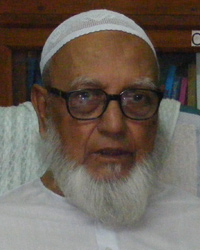 Golam Azam ()
Golam Azam () 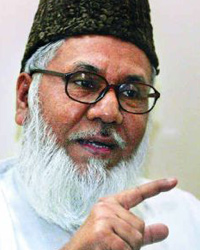 Maulana Motiur Rahman Nizami ()
Maulana Motiur Rahman Nizami () 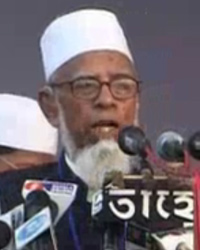 Maulana A.K.M. Yusuf ()
Maulana A.K.M. Yusuf () 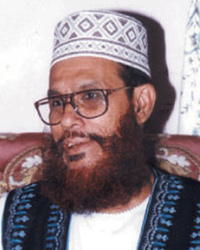 Delwar Hossain Sayeedi ()
Delwar Hossain Sayeedi () 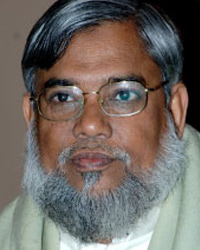 Ali Ahsan Mohammad Mujahid ()
Ali Ahsan Mohammad Mujahid () 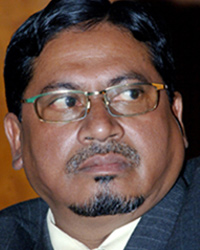 Muhammad Qamruzzaman ()
Muhammad Qamruzzaman () 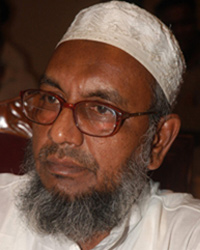 Abdul Quader Molla ()
Abdul Quader Molla ()
However, the Jamaat-e-Islami, known to be a moderate Islamic party, deny all war criminal charges and point to the fact that these accusation have only come about in recent years - 30+ years after the war. Numerous political parties have ruled Bangladesh during that time, including the Awami League, however, none have previously made any charges against the Jamaat. In addition, of the 195 criminals wanted by the Awami League after Bangladesh gained victory, none of them were Jamaat members. They believe that the charges, made by the Awami League government of Bangladesh, are politically motivated and intended to weaken the solidarity that the Jamaat historically enjoins with BNP, the Awami League's main opposition.
I am yet to find answer to one question – that is, no one called us ‘war criminals’ until 30 years after 1971.
There had been war criminals. Sheikh Mujib himself solved this issue. He identified 195 Pakistani officers as war criminals with no mention of any civilians. He had also passed a law to punish them. They are now trying to put us on trial under this law. He made a list, passed a law to try them, but then forgave and freed them all after meeting Bhutto in Shimla. He branded those he thought to be their associates as ‘collaborators’ and passed a separate law to punish them. Around 100,000 people were arrested under this law. He tried a few of them, but when he realized that there were very few witness and little evidence could be found against the accused, then he forgave them all by declaring a general amnesty. So, he resolved it, he resolved the issue of war crimes. Now after 30 years, it is now 40 years. Why have they raised this issue once again after 40 years?
We were in movement against Ershad’s autocratic rule. BNP – Awami League – Jamaat were in the movement together where they sat with us in Liaison Committee meetings. Then we were not war criminals.
Golam Azam, Ex-Ameer of Jamaat-e-Islami (Bangladesh)
By highlighting the Islamic and Pakistani affiliations of the Razakars, the left-liberal activists show that the genocidal birth of Bangladesh continues to be unacknowledged and that the secular nationalism that the formation of Bangladesh promised is yet to be achieved. This, nonetheless, does not address the ways in which many of these same activists supported Islamic Pakistan in 1947 and a Bengali Muslim identity 25 years later during the formation of Bangladesh against Islamic West Pakistan. Also unaddressed is the current decrepit [weakened], liminal [low physiological or psychological] conditions occupied by the Biharis and the rape of Bihari women in 1971.
Sharika Thiranagama & Tobias Kelly, authors of "Traitors: Suspicion, Intimacy, and the Ethics of State-Building" (2011)
The Razakar force disintegrated with the surrender of the Pakistan army on 16 December 1971.
From 'helper' to 'vile conspirator'
The circumstantial and historical effects has changed the meaning of the word razakar.
In contemporary Bangladesh, 'Razakar' or 'Razakarer bachcha' (child of a Razakar) is used as a verbal abuse like the terms Judas in Europe or Mir Jafar in West Bengal to highlight that this person is bound to betray, is scheming, has malicious intentions, and is untrustworthy.
